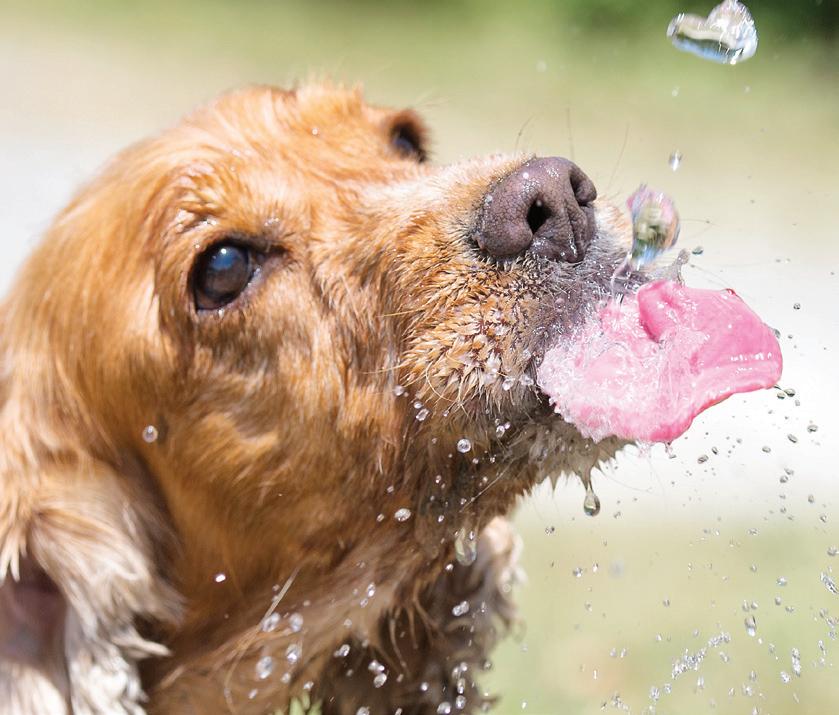
3 minute read
PET HYDRATION & WATER TOXICITY
JULY IS NATIONAL PET HYDRATION
AWARENESS MONTH
Advertisement
(Humans are made up of 65% water) This is why people and pets need water to properly maintain all body functions. How much water do our pets need? Cats or dogs need approx.
½ to 1 ounce of water per pound daily depending on diet (canned food contains more water), age, activity level and time of year. – Always have fresh water available & clean bowl daily. – Consider a water fountain. They’re great for the finicky cat who prefers fresh running water. – Create a couple of water stations in different locations. – Add variety: Ice cubes in their water bowl, make frozen treats.
Stay COOL and HYDRATED this summer!
HYDRATION u What if a dog ingests too much water?
Summers in Las Vegas are HOT!
Keeping ourselves and our dogs hydrated in our area is a huge challenge. Drinking an ample amount of water is essential. However, though not as common as dehydration there is a condition called “water toxicity” or overhydration. It is possible for a dog to ingest more water than they can eliminate. This can cause hyponatremia, a condition where sodium levels drop dangerously low and upset the electrolyte balance. When this happens the body’s water levels rise and cells absorb the excess fluid and swell. This affects all vital organs, brain cells and even the central nervous system.
The good news is that water toxicity in dogs is relatively rare and doesn’t happen often but the bad news is that it develops quickly and that it can be life threatening. All dogs are at risk but there are some groups that are more at risk:
WATER-LOVING DOGS: It is most often seen in waterloving canines who would stay in the lake, pond or pool all day if you let them, pets that lap or bite at the water continuously while playing in it and dogs that swallow water unintentionally as they dive for a ball or other toy.
DOGS WITH LITTLE BODY FAT: Muscular dogs with less body fat do not have the extra fat tissue to help absorb the excess fluid and it is absorbed by the body leading to water toxicity.
DOGS WITH HIGH ENERGY: They are highly focused and will keep jumping, diving, retrieving the ball or stick until their parents stop them.
SMALL DOGS: Small dogs have lower capacity for water and it takes less time for water to accumulate in their bodies and they tend to develop symptoms quickly. AWARENESS [ It is important to be aware that water toxicity is a potential danger to your dog. Know the symptoms and if your dog has been in or around water and exhibits some of the symptoms it is important to seek veterinarian care immediately. Treatment usually includes IV delivery of electrolytes, diuretics and drugs to reduce brain swelling.
SYMPTOMS [ Lethargy, lack of coordination, bloating; glazed eyes, vomiting, pale gums, nausea, dilated pupils, excessive drooling and more advanced symptoms such as difficulty breathing, collapsing, loss of consciousness, and seizures.
A few ideas to help prevent over hydration:
• Supervise your pet whenever they are in or near water. Be especially careful on days when the water is rough. • Take frequent breaks and give them an opportunity to pee to get rid of extra water in the body. • Watch your dog closely when they are in a body of water and if their mouth is open a lot, they are probably ingesting water. • If your dog likes to play in or drink from the hose or sprinkler direct the hose at their body instead of directly into their mouth. Since water from a hose is pressurized, they can ingest a great deal of water in a short period of time.
Summer fun and water safety go hand-in-hand. Be aware of both challenges – making sure your pets are hydrated and protecting them from over hydration. Stay cool, have fun AND please stay safe!

LAS VEGAS’ LONGEST ESTABLISHED LEASH TRAINER.










